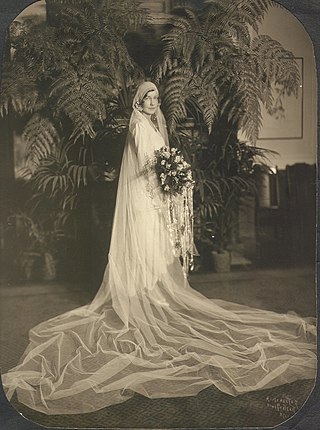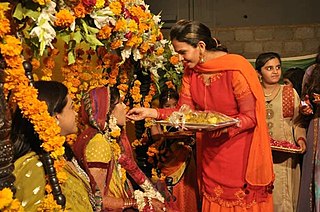
An engagement ring, also known as a betrothal ring, is a ring indicating that the person wearing it is engaged to be married, especially in Western cultures. A ring is presented as an engagement gift by a partner to their prospective spouse when they propose marriage or directly after a marriage proposal is accepted. It represents a formal agreement to future marriage. In most Western countries, engagement rings are worn mostly by women, and rings can feature diamonds or other gemstones. The neologism "mangagement ring" is sometimes used for an engagement ring worn by men. In some cultures, including Northern Europe, both partners wear matching rings, and engagement rings may also be used as wedding rings. In the Anglosphere, the ring is customarily worn on the left hand ring finger, but customs vary considerably elsewhere across the world.

An engagement or betrothal is the period of time between the declaration of acceptance of a marriage proposal and the marriage itself. During this period, a couple is said to be fiancés, betrothed,intended, affianced, engaged to be married, or simply engaged. Future brides and grooms may be called fiancée (feminine) or fiancé (masculine), the betrothed, a wife-to-be or husband-to-be, respectively. The duration of the courtship varies vastly, and is largely dependent on cultural norms or upon the agreement of the parties involved.

A bride is a woman who is about to be married or who is a newlywed.
Bridesmaids are members of the bride's party at some Western traditional wedding ceremonies. A bridesmaid is typically a young woman and often the bride's close friend or relative. She attends to the bride on the day of a wedding or marriage ceremony. Traditionally, bridesmaids were chosen from unwed young women of marriageable age.
Breach of promise is a common-law tort, abolished in many jurisdictions. It was also called breach of contract to marry, and the remedy awarded was known as heart balm.
In Islamic law (sharia), marriage is a legal and social contract between two individuals. Marriage is an act of Islam and is strongly recommended. Polygyny is permitted in Islam under some conditions, but polyandry is forbidden.
Etiquette rules in the United States and Canada generally apply to all individuals, unlike cultures with more formal class structures, such as those with nobility and royalty.

Marriage in Pakistan pertains to wedding traditions established and adhered by Pakistani men and women. Despite their local and regional variations, marriages in Pakistan generally follow Islamic marital jurisprudence. Marriages are not only seen as a union between a husband and a wife, but also an alliance between their respective families. These traditions extend to other countries around in the world where Overseas Pakistani communities exist.

An engagement party, also known as a betrothal party or fort, is a party held to celebrate a couple's recent engagement and to help future wedding guests to get to know one another. Traditionally, the bride's parents host the engagement party, but many modern couples host their own celebration.
Arabic weddings are ceremonies of matrimony that contain Arab influences or Arabic culture.
In the United States and Canada, weddings follow traditions often based on religion, culture, and social norms. Most wedding traditions in the United States and Canada were assimilated from other, generally European, countries. Marriages in the U.S. and Canada are typically arranged by the participants and ceremonies may either be religious or civil. There is a tradition that the prospective bridegroom ask his future father-in-law for his blessing.

Traditional marriage customs in the Philippines and Filipino wedding practices pertain to the characteristics of marriage and wedding traditions established and adhered by them Filipino men and women in the Philippines after a period of adoption courtship and engagement. These traditions extend to other countries around the world where Filipino communities exist. Kasalan is the Filipino word for "wedding", while its root word – kasal – means "marriage". The present-day character of marriages and weddings in the Philippines were primarily influenced by the permutation of Christian, both Catholic and Protestant, Hindu, Islam, Chinese, Spanish, and American models.

Muslim marriage and Islamic wedding customs are traditions and practices that relate to wedding ceremonies and marriage rituals prevailing within the Muslim world. Although Islamic marriage customs and relations vary depending on country of origin and government regulations, both Muslim men and women from around the world are guided by Islamic laws and practices specified in the Quran. Islamic marital jurisprudence allows Muslim men to be married to multiple women.
Engagement chicken is a lemon and herb flavored roast chicken dish, purported to cause boyfriends to propose marriage.
A marriage proposal planner is a professional event coordinator who specializes in planning marriage proposals. A proposal planner is a relatively new profession in the wedding industry. Proposal planners suggest marriage proposal ideas, scout proposal locations, negotiate rates with vendors, draw up contracts, hire photographers, create romantic setups, acquire permits, and help clients choose engagement rings. Proposal planners interview the proposer and ask questions about the couple. They then use those answers to create a unique proposal idea.
Bachelor's Day, sometimes known as Ladies' Privilege, is an Irish tradition by which women are allowed to propose to men on Leap Day, 29 February, based on a legend of Saint Bridget and Saint Patrick. It once had legal basis in Scotland and England.

Bride price, bride-dowry, bride-wealth, bride service or bride token, is money, property, or other form of wealth paid by a groom or his family to the woman or the family of the woman he will be married to or is just about to marry. Bride dowry is equivalent to dowry paid to the groom in some cultures, or used by the bride to help establish the new household, and dower, which is property settled on the bride herself by the groom at the time of marriage. Some cultures may practice both simultaneously. Many cultures practiced bride dowry prior to existing records.
Wedding customs in Ethiopia vary among the tribes of the country.









